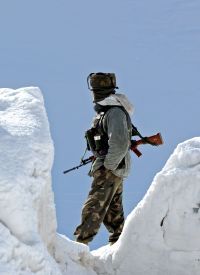
'The necessity of a Mountain Strike Corps is well understood. The problem is in implementing the intention,' says Nitin Gokhale.
Defence Minister Manohar Parrikar has made an unambiguous statement that the Mountain Strike Corps for the Indian Army will be frozen at the current level -- which is to say at about 50 per cent of the originally proposed strength of over 80,000 troops because of a funds crunch.
Army HQ is about to order an internal assessment on how to adapt to the political directive and at the same time beef up the capability against China.
The ongoing army commanders conference in Delhi, where the army's topmost leadership gathers twice a year, had a preliminary discussion on ways to balance the need to acquire an offensive capability against China and the fiscal reality.
Informed sources said the army's top brass will look at the possibility of internal accruals by tweaking its ORBAT (Order of Battle) against Pakistan.
In simpler terms, an assessment is likely to be ordered to relook at the three existing strike corps (1, 2 and 21) ranged against Pakistan.
Similarly, a review of the deployment of some of the dual-tasked formations like the 39 Division and 6 Division is on the cards.
The armour- and mechanised infantry-heavy strike corps are all deployed on the Western Front. They are considered essential for the 'Cold Start' doctrine -- designed for lightening strikes against Pakistan in the event of a war -- that the Indian Army propounded after the experience of Operation Parakram in 2002, when the strike formations took a long time to mobilise, forcing the then government to go slow on its plan to punish Pakistan in the wake of the attack on Parliament.
Since both the political executive and the army brass agree that India must move from a dissuasion posture against China to a credible deterrence to maintain the power equilibrium in Asia, the necessity of a Mountain Strike Corps is well understood across the board.
The problem is in implementing the intention. The previous government sanctioned an ambitious Mountain Strike Corps with a proposed strength of 80,000 soldiers costing Rs 64,000 crores (Rs 640 billion) to be spent over a seven year period.
The catch was: The Mountain Strike Corps remained only on paper since the requisite funds were never allocated by Dr Manmohan Singh's government.
The army nevertheless went ahead and raised the flag of the new corps -- numbered 17 -- on January I, 2014 by cannibalising reserves from existing formations.
During a review after taking over as defence minister, Parrikar discovered that the War Wastage Reserves -- WWRs -- of the army were being diverted to the new corps. He first ordered a halt to that process and told the army to tweak its plans for the 17 Corps.
In a way, the resizing of the Mountain Strike Corps is a blessing in disguise for both the Northern and Eastern Commands, ranged against the Chinese. Neither command currently have the requisite infrastructure to base new formations in the difficult terrains of Ladakh, Arunachal Pradesh and Sikkim.
A gradually accretion in the strength of the 17 Corps which eventually will have dual tasking in the Eastern and Northern Commands, will follow once the infrastructure is in place.
Till then, hopefully, the Indian economy will have enough heft to spare the required funds for the full-fledged Mountain Strike Corps.










